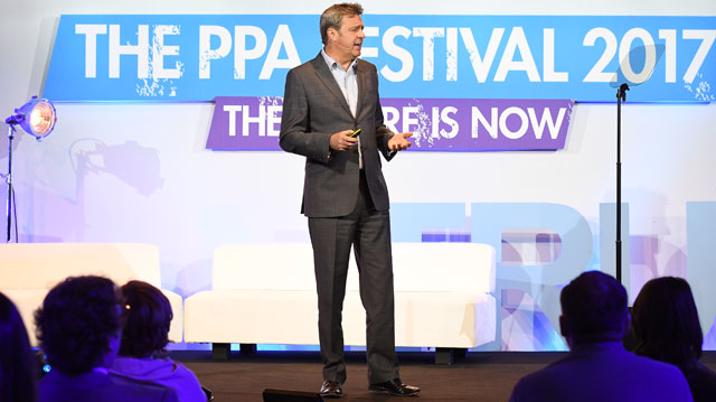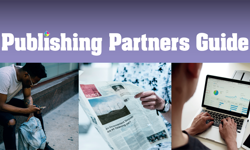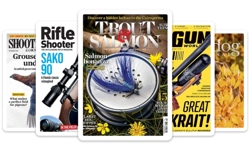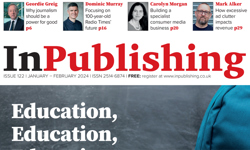
Tipping point?
No one is ever going to stand up at a PPA event and say, “we’re all doomed”. Resolute optimism is de rigueur. Reasons to be cheerful and talk of tipping points peppered the day at the recent PPA Festival.
“Bring it on!” urged Marcus Rich, CEO of Time Inc UK, kicking off the annual Marcus Morris Lecture. Yes, we were living through “challenging times” with advertising continuing its downward spiral and consumer attention-span ever decreasing. Tectonic shifts in the industry were putting huge pressure on us all.
Yet, he continued, this is the “most exciting time for magazine publishers” and, he sensed, we were at a “tipping point” with people beginning to look at our industry in a more positive light.
The first signs that not everything is tickety-boo in the advertising proposition of the digital behemoths comes at a time when senior marketing figures are already beginning to question the efficacy of digital advertising. This has provided a much-needed tonic for magazine publishers.
The ongoing brouhaha around the abundance and seemingly uncontrolled flow of fake news on the social media platforms, closely allied to the revelation that misplaced ads from reputable companies were helping to fund both the sources of fake news along with extremist and terrorist groups too, has presented mainstream media with an opportunity to remind advertisers of their credentials as a trusted medium.
Rich quoted marketing consultant Peter Field: “There is something very wrong and something very broken in the world of marketing at the moment.” Field was referring to the over-reliance on short term metrics in assessing campaign RoI. Marketers were overly focused on short-term activations at the expense of brand building and a rebalancing was due. Rich clearly felt that publishers, through their highly engaged audiences, were well place to profit from any rebalancing.
But the problem for the big digital players goes beyond the choice of marketing strategies deployed by advertisers. There is an increasing sense that advertisers are getting ripped off by Facebook et al. Much has been made of the comments by Procter & Gamble’s Marc Pritchard who has been quoted as saying that the digital supply chain was “murky at best and fraudulent at worst”. Pritchard has been particularly scathing about poor adoption of industry standards and a tendency to “mark their own homework”.
So, how then are magazine publishers well placed to capitalise on this rare misstep in the seemingly unstoppable march of social media. Rich pinpointed four attributes:
1. We have passionate audiences
Passion is good. Passionate communities spend money on their passions and don’t feel guilty about doing so. The benefits for advertisers are self-evident. Furthermore, our brands are good long-term bets, as passion begets passion. Rich referred to research showing that 90% of people pass their passion onto their kids; he himself could point to the fact that he had saddled his own offspring with a lifelong passion for West Ham United.
2. We provide a safe and relevant environment
As Martin Sorrell said, “it’s not about time, it’s about engagement”. The number of impressions alone is an increasingly meaningless statistic. It’s all about the number of relevant impressions, and publishers deliver that relevance. A well targeted ad on a premium magazine website will not fund extremists but will be seen by potential customers in an environment where they have chosen to spend valuable leisure time. As Rich said, targeting alone is not enough. If it were, then Rolex would only advertise in the urinals of the Square Mile.
3. We have the content
“People will always want to hear a story well told,” asserted Rich. Quoting Randall Stephenson, AT&T CEO, “premium content always wins”. The key word there is ‘premium’; Facebook is awash with content, but much of its quality is variable and its provenance questionable. Professionally produced, edited and curated content is priceless, and whatever Facebook’s undoubted strengths, they’ll never have that; not unless they upend their entire business model.
4. We have the data
Publishers like Time Inc UK are repositories of huge amounts of highly valuable first party data about their customers and users which helps ensure the best possible targeting of advertising messages.
Marcus Rich concluded his upbeat talk by saying that “interruptive advertising is on the wane” and native advertising is on the rise. By 2021, he said, 74% of advertising would be native and, because of publishers’ pedigree in the field of content, they are well placed to take a good share of that. The new battlefield is content, but, he warned, we must be wary of the tanks already parking on our lawn. We have the advantage and we must seize the opportunity.
Let him who is without sin…
Mainstream media (MSM) has been quick to latch onto ‘fake news’, seeing in its widespread occurrence on social media an opportunity to make the issue of credibility one of the key differentiators between social media and MSM. You don’t find that kind of rubbish on our professionally edited sites was the implication.
But the fake news phenomenon is a threat to MSM as well; partly because it appears on our pages too (the Zinoviev letter was published in the Daily Mail in 1924) and partly due to the fact that we’re being tarred with the same brush. In the US, trust in all media has declined markedly, in part due to President Trump’s cynical smearing of his critics in the press as “fake news”.
Fake news was the subject of a fascinating panel session at the PPA Festival. The panel consisted of David Hepworth, BMJ editor-in-chief Dr Fiona Godlee and James Ball, special correspondent at BuzzFeed and was moderated by Ray Snoddy.
Fiona Godlee said that fake news, which she defined as the “deliberate spread of false information for gain”, was as old as the world’s second oldest profession. It was, she said, a very real problem in the medical press as it directly impacted on people’s health. She referenced a recent outbreak of mumps in Texas, a state with one of the lowest take-ups of the MMR vaccine in the US, due to the now debunked theories of Andrew Wakefield published in The Lancet.
Interestingly, MSM, in the form of medical journals, carries a heavy responsibility for the spread of fake news. In the healthcare arena, the source of the stories is not extremist groups but rather the powerful vested interests of the tobacco, food and pharmaceutical industries. These groups fund most of the research and therefore hold much of the data, ruthlessly controlling what gets published. This “toxic mix”, says Godlee, results in the “systematic over-statement of benefits and the understatement of harms. Misinformation kills people and wastes resources.”
The industry can do something about it – her eight-point plan includes: make the peer-review process more robust * improve transparency * increase the penalties * stop pharma companies funding trials * educate the public; engender a healthy scepticism * improve the training of journalists * fund investigative journalists * platforms must take responsibility for what they publish
BuzzFeed’s James Ball picked up on this last point. As an industry, he said, we’ve tended to look at fake news as “someone else’s problem – not our problem; except of course it is. We’re all responsible for where we’re at now, not just the Macedonian teenagers. We must all look at everything we do and eradicate hype and tendentiousness in our work. We must check what we publish. If we’re going to run nonsense, then what happens to trust?”
Publishers must make sure their own houses are in order. More broadly, algorithms are not going to be enough to stop the spread of fake news on social media, because, simply it’s too blunt an instrument and, as a wider society, we can’t abrogate our responsibility to fact checkers. Quoting Clay Shirky, who wrote last July on the subject of opposing Donald Trump’s candidacy: “we’ve bought fact-checkers to a culture war.” In short, too little, too late and preaching to the converted.
James Ball said that whilst tech solutions could help, we didn’t want Facebook (or the government for that matter) becoming the arbiter of what we read. In any event, he said ominously, “fake news is just the tip of the iceberg”.
According to Fiona Godlee, there is only one time when fake news is permissible – to be encouraged even – and that’s the first day of April. On 1st April 2006, the BMJ ran a fascinating piece on the little-known condition, motivational deficiency disorder (MoDeD), which proved that there “was a medical basis for extreme laziness”. The BMJ continued, straight-faced, that the “condition is claimed to affect up to one in five Australians and is characterised by overwhelming and debilitating apathy”. Despite being clearly dated, the article was subsequently picked up and reported as real news by some news outlets. I think one of those outlets might have been in New Zealand, so it’s possible that they knew exactly what they were doing.










